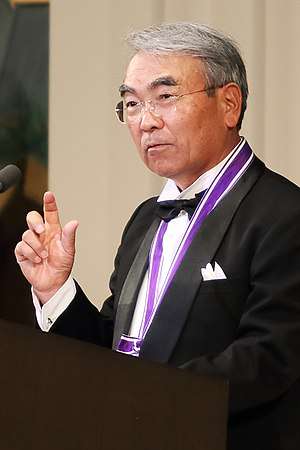Takeo Kanade
| Takeo Kanade | |
|---|---|
|
Dr Takeo Kanade in 2016 Kyoto Prize Presentation Ceremony | |
| Born |
October 24, 1945 Hyōgo, Japan |
| Residence | United States |
| Nationality | Japanese |
| Fields |
Computer vision Robotics |
| Institutions |
Carnegie Mellon University Kyoto University |
| Alma mater | Kyoto University |
| Academic advisors | Makoto Nagao |
| Known for | Lucas–Kanade method Tomasi-Kanade method Face Detection Virtualized Reality |
Takeo Kanade (金出 武雄 Kanade Takeo, born October 24, 1945 in Hyōgo) is a Japanese computer scientist and one of the world's foremost researchers in computer vision. He is U.A. and Helen Whitaker Professor at Carnegie Mellon University. He has approximately 300 peer-reviewed academic publications and holds around 20 patents.[1]
Honors and achievements
- In 1999 he was inducted as a Fellow of the Association for Computing Machinery.
- In 2008 Kanade received the Bower Award and Prize for Achievement in Science from The Franklin Institute in Philadelphia, Pennsylvania.[2]
- A special event called TK60: Celebrating Takeo Kanade's vision was held to commemorate his 60th birthday.[3] This event was attended by prominent computer vision researchers.
- Elected member of National Academy of Engineering, the American Academy of Arts and Sciences
- Elected member of American Association of Artificial Intelligence, Robotics Society of Japan, and Institute of Electronics and Communication Engineers of Japan
- Marr Prize, 1990 for the paper Shape from Interreflections which he co-authored with Shree K. Nayar and Katsushi Ikeuchi[4]
- Longuet-Higgins Prize for lasting contribution in computer vision at
- The other awards he has received include the C&C Award, the Joseph Engelberger Award, FIT Funai Accomplishment Award, the Allen Newell Research Excellence Award, and the JARA Award.
- He has served for many government, industrial, and university advisory boards, including the Aeronautics and Space Engineering Board (ASEB) of the National Research Council, NASA's Advanced Technology Advisory Committee, PITAC Panel for Transforming Healthcare Panel, and the Advisory Board of Canadian Institute for Advanced Research.[9]
- In 2016 Kanade received the Kyoto Prize in Information Sciences.[10]
Notable works
- Lucas–Kanade method[11]
- One of the earliest face detectors[5]
- Tomasi–Kanade factorization method[12]
- Virtualized Reality[13]
- Multi-baseline stereo and the world's first full-image video-rate stereo machine [14]
- VLSI computational sensors[15]
- Shape recovery from line drawings (known as Origami World theory and skew symmetry)[16]
External links
- Takeo's Home Page at the Robotics Institute, CMU.
- Envisioning Robotics Online Archival Exhibit
References
- ↑ Takeo Kanade's personal website
- ↑ http://www.fi.edu/franklinawards/08/laureate_bowers-kanade.html
- ↑ http://www.ri.cmu.edu/events/tk60/
- ↑ http://tab.computer.org/pamitc/conference/best-paper-awards.html
- 1 2 Henry Rowley; Shumeet Baluja; Takeo Kanade (June 1996). "Neural Network-Based Face Detection". Computer Vision and Pattern Recognition '96.
- ↑ graphics.stanford.edu/~vaibhav/talks/cvpr06.ppt
- ↑ http://vision.eecs.ucf.edu/
- ↑ Henry Schneiderman; Takeo Kanade (July 1998). "Probabilistic Modeling of Local Appearance and Spatial Relationships for Object Recognition". Proceedings of the IEEE Conference on Computer Vision and Pattern Recognition (CVPR '98): 45–51.
- ↑ http://www.ri.cmu.edu/events/tk60/bio.html
- ↑ Kyoto Prize 2016
- ↑ An Implementation of the Kanade–Lucas–Tomasi Feature Tracker
- ↑ Carlo Tomasi; Takeo Kanade (November 1992). "Shape and motion from image streams under orthography: a factorization method". International Journal of Computer Vision. 9 (2): 137–154. doi:10.1007/BF00129684.
- ↑ Takeo Kanade; Peter Rander; P J Narayanan (January 1997). "Virtualized Reality: Constructing Virtual Worlds from Real Scenes". IEEE Multimedia, Immersive Telepresence. 4 (1): 34–47. doi:10.1109/93.580394.
- ↑ Takeo Kanade; Atsushi Yoshida; Kazuo Oda; Hiroshi Kano; Masaya Tanaka (1996). "A Stereo Machine for Video-rate Dense Depth Mapping and its New Applications". Ieee Cvpr.
- ↑ Vladimir Brajovic; Takeo Kanade (August 1998). "Computational Sensor for Visual Tracking with Attention". IEEE Journal of Solid State Circuits. 33 (8): "1199–1207. doi:10.1109/4.705358.
- ↑ Takeo Kanade (June 1980). "A Theory of Origami World". Artificial Intelligence. 13: 279–311. doi:10.1016/0004-3702(80)90004-1.
This article is issued from
Wikipedia.
The text is licensed under Creative Commons - Attribution - Sharealike.
Additional terms may apply for the media files.
